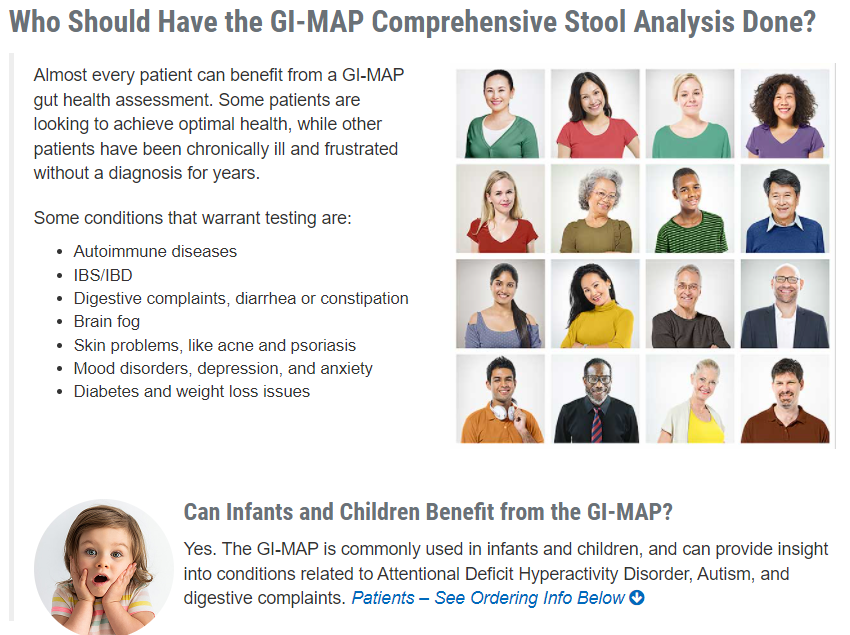GI-MAP | GI Microbial Assay Plus
The Gastrointestinal Microbial Assay Plus (GI-MAP) is an innovative clinical tool that measures gastrointestinal microbiota DNA from a single stool sample with state of the art, quantitative polymerase chain reaction (qPCR) technology. The GI-MAP was designed to detect microbes that may be disturbing normal microbial balance or contributing to illness as well as indicators of digestion, absorption, inflammation, and immune function.
|
PATHOGENS
The GI-MAP® includes pathogens (bacterial, parasitic, and viral) commonly known to cause intestinal gastroenteritis. It's important to note that not all individuals with positive findings for pathogens will present with symptoms. Many factors, including the health of the individual, the transient nature of some pathogens, and the presence and expression of virulence factors all contribute to an individual's symptoms. Toxins are a type of virulence factor produced by certain pathogens. Since GI-MAP is a DNA-based test, results reflect the levels of pathogenic strains carrying the toxin genes, not the levels of any toxins that may be produced. |
H. pylori
Recent studies have shown that nearly 50% of the world's population may harbor H. pylori. And, although many carriers are asymptomatic, H. pylori is known to have a causative role in ulcers, chronic gastritis, and stomach cancer. Additionally, in early phases of colonization, patients may experience hypochlorhydria followed by a change to hyper aciduria. Over time, additional H. pylori strains may colonize, including those with Virulence Factors and increased disease potential. |
NORMAL/COMMENSAL BACTERIA
Trillions of microorganisms inhabit the human intestine to make up a complex ecosystem that plays an important role in human health. Commensal bacteria extract nutrients and energy from our diets, maintain gut barrier function, produce vitamins (biotin and vitamin K), and protect against colonization by potential pathogens. PARASITES A parasite is an organism that lives and feeds on a host organism at the expense of the host. The GI-MAP tests for pathogenic parasites and protozoa (some of which are non-pathogenic) most commonly occurring in the GI tract. Sources of exposure should be identified and eliminated to prevent reinfection. |
|
OPPORTUNISTIC/OVERGROWTH MICROBES
Many bacteria measured on the GI-MAP are considered opportunistic pathogens, as they only cause disease and illness in some individuals, particularly the immune-compromised. Many individuals come into contact with opportunistic bacteria and experience no symptoms. Most sources consider these microbes to be normal in the stool. However, they can cause gastroenteritis and inflammation at high levels in vulnerable patients. Symptoms may include diarrhea, loose stools, abdominal pain, or even constipation. Overgrowth and excessive colonization by opportunistic bacteria may occur when the commensal bacteria are impaired by poor diet, antibiotic use, parasitic infection, or a weakened immune system. When intestinal permeability is present (see zonulin), these microbes could escape the lumen of the gut and infect extraintestinal sites. |
FUNGI/YEAST
Fungal organisms are commonly found in the human digestive tract, but fungal overgrowth can cause illness in susceptible individuals. Fungal growth may be localized in the body. For instance, Candida spp. may be high in the large intestine but normal in the small intestine, and vice versa. In a patient with suspected fungal overgrowth, additional tests may be necessary to understand the complete picture of fungal overgrowth. Urinary D-arabinitol or antibodies to Candida are sometimes used. INTESTINAL HEALTH MARKERS DIGESTION - Elasrase-1 - Steatocrit IMMUNE RESPONSE - SIgA - Anti-gliadin SIgA INFLAMMATION - Calprotectin GI MARKERS - β-Glucuronidase ADD ON TESTS - Zonulin |
ANTIBIOTIC RESISTANCE GENES
The GI-MAP includes results for detection of antibiotic resistance genes in the microbiome. If an antibiotic resistance gene is present, then that class of antibiotics is designated POSITIVE for antibiotic resistance. A positive result for the presence of resistance genes for a given antibiotic indicates that the antibiotic is not an ideal choice for an antibiotic protocol. Antibiotic resistance genes apply to all of the microorganisms found in the fecal sample. Since microbes can rapidly share DNA under stress, the presence of antibiotic resistance in any organism is reason enough to avoid that drug class. Phenotypes | HELOBACTER
|

